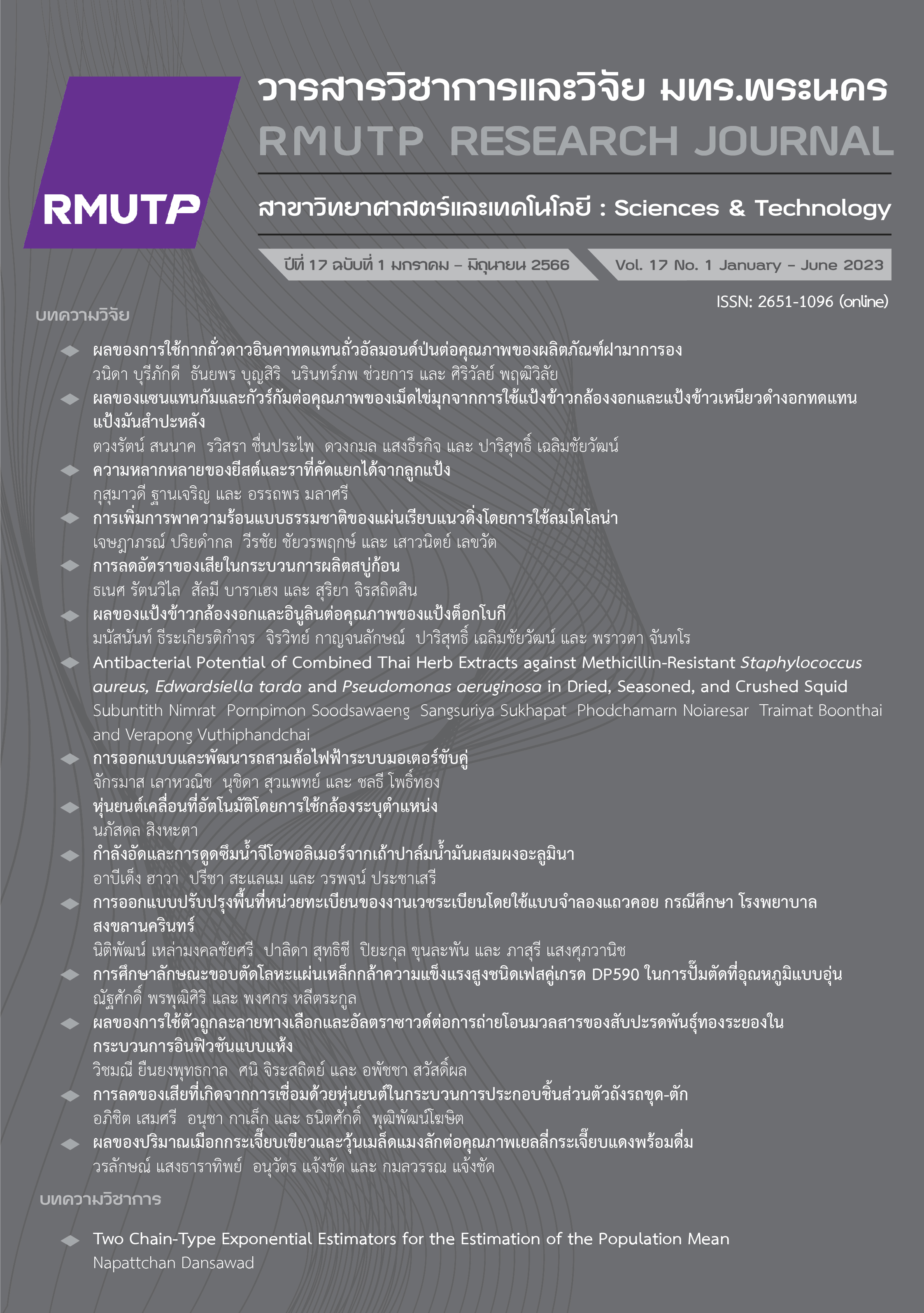Effect of Using Sacha Inchi Pressed-Cake as a Substitute for Almond Powder on the Quality of Macaron Shell Product
Main Article Content
Abstract
This research aimed to study the suitable content of sacha inchi pressed-cake instead of using almond powder in macaron shells. They were substituted in flour different levels; 0%, 40%, 60%, and 80% by almond powder weight. The results showed that sacha inchi press-cake was substituted for almond powder at 60% with a moderate score for all measured sensory traits. The L* value and moisture were decreased (p<0.05) but the a* value trend was increased (p<0.05) with a higher amount of sacha inchi pressed-cake. The fracturability, b* value, and water activity (aw) values were not significantly different (p>0.05). The content of ash, crude fiber, protein, nine essential amino acids (Histidine, Isoleucine, Leucine, Lysine, Methionine, Phenylalanine, Threonine, Valine, and Tryptophan), and five non-essential amino acids (Arginine, Glycine, Proline, Serine, and Tyrosine) were increased about one time. Moreover, the cost of macaron shell with Sacha Inchi pressed-cake weighing 3 grams was approximately 1.3 baht per piece.
Article Details

This work is licensed under a Creative Commons Attribution-NonCommercial-NoDerivatives 4.0 International License.
ลิขสิทธ์ ของมหาวิทยาลัยเทคโนโลยีราชมงคลพระนครReferences
A. Wu, “Optimizing sugar ratios for macaroon taste and structure,” Food Science, vol. 1, pp. 1-12, 2012.
P. Chunkamol and K. Vassana, “Development of almond powder substitute macaron from cashew nut powder,” Srinakharinwirot University, Journal of Science and Technology, vol. 10, no.19, pp. 14-30, 2018.
B. Athip and S. Napat, “Processing of egg white pastries (macaroon) by using peanut and cashew nut powder as almond powder replacement,” Dusit Thani College Journal, vol. 12, no. 2, pp. 182-192, 2018.
G. Sethuraman, N. M. M. Nizar, F. N. Muhamad, P. J. Gregory, E. Jahanshiri and S. Azam-Ali, “Nutrition composition of sacha inchi (Plukenetia Volubilis L.),” International Journal of Research and Scientific Innovation, vol. 7, no. 9, pp. 271-277, 2020.
N. Chuaykarn, S. Pruettiwilai and W. Bureepukdee, “The application of legumes using in macaroon product,” Agricultural Science Journal (supplement), vol. 50, no. 2, pp. 1-4, 2019.
K. Tanisorn, “Product development of macarons from sacha inchi (Plukenetia Volubilis L.),” M.H.E. thesis, Dept. Food. Nutr., RMUTP Univ., Bangkok, Thailand, 2018.
AOAC, Official Methods of Analysis of AOAC International, 21st ed. USA: Gaithersburg, MD. 2019.
G. Charalambous, “Chromatographic analysis of food and beverages,” in Proceedings of a Symposium on the Analysis of Foods and Beverages by HPLC, U.S.A., 1979, pp. 1-12.
R. Nithiya, “Carbohydrate,” in Food chemistry, 5th ed. Bangkok, Thailand: Odeon Store Publisher, pp. 137-188, 2014.
S. Manisa, T. Taweesak and S. Nongnuch, “Preparation and application of dried almond residue for substitution of almond flour in macaron,” Thai Science and Technology Journal, vol. 28, no. 9, pp. 1572-1584, 2020.
E. Bakkalbasi, R. R. Meral and I. S. Dogan, “Bioactive compounds physical and sensory properties of cake made with walnut press-cake,” Journal of Food Quality, vol. 38, no. 6, pp. 422-430, 2015.
S. C. Young, “The quality characteristics of macaroon added with Helianthus Tuberosus L. powder,” Culinary Science & Hospitality Research, vol. 23, no. 1, pp. 28-36, 2017.
T. G. Kudre and S. Benjakul, “Effects of binary organic solvents and heating on lipid removal and the reduction of beany odour in Bambara groundnut (Vigna subterranean) flour,” Food Chemistry, vol. 141, no. 1, pp. 517-523, 2013.
Y. Wichamanee, C. Sirima and K. Nisanart, “Effect of roasting conditions on beany odor retention and chemical properties of sacha inchi flour,” The journal of KMUTNB, vol. 29, no. 1, pp. 135-144, 2019.
Thai Community Product Standard, 118, 2012.
S. Rawdkuen, D. Murdayanti, S. Ketnawa and S. Phongthai, “Chemical properties and nutritional factors of pressed-cake from tea and sacha inchi seeds,” Food Bioscience, vol. 15, pp. 64-71, 2016.
R. Kultida, H. Chatrapa and S. Promluck, “Effect of sacha inchi pressed-cake (Plukenetia volubilis L.) on the physical chemical and sensory properties of tuiles,” Chiang Mai University Journal of Natural Sciences, vol. 20, no. 2, pp. 1-10, 2021.
L. A. Follegatti-Romero, C. R. Piantino, R. Grimaldi and F. A. Cabral, “Supercritical CO2 extraction of omega-3 rich oil from sacha inchi (Plukenetia volubilis L.) seeds,” Journal of Supercritical Fluids, vol. 49, pp. 323-329, 2009.
P. Anamaria, A. Paucean, S. Ancut, S. Ersilia, A. Simona, M. Maria, S. Liana, P. Luliana, B. Adina and M. Sevastita, “Quality characteristics and volatile profile of macarons modified with walnut oilcake by-product,” Molecules, vol. 25, no. 2214, pp. 1-19, 2020.
P. C. Calder, “Functional roles of fatty acids and their effects on human health,” Journal of Parenteral and Enteral Nutrition, vol. 39, no. 1, pp. 18-32, 2015.
C. Ruiz, C. Diaz, J. Anaya and R. Rojas, “Proximate analysis, antinutrients, fatty acids and amino acids profiles of seeds and cakes from 2 species of sacha inchi (Plukenetia volubilis y and Plukenetia huayllabambana),” Revista de la Sociedad Química del Perú, vol. 79, no. 1, pp. 29-36, 2013.


